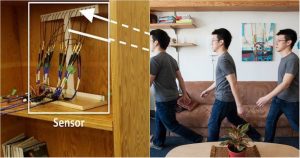
MIT Scientists Now Invented A Wireless Device That Measures The Walking Speed With 99 Percent Accuracy
The 21st century is already full of innovations, starting from the wristbands that are used to measure the heartbeat, to the extensive development of robots that can be utilized in the manufacturing industries and medical purposes, there’s no going back. In addition to this enormous progress, the Massachusetts Institute of Technology (MIT) scientists have developed a novel device that can measure the walking speed of multiple people with up to 99 percent accuracy using wireless signals.
They named it “WiGait”, the device measures walking speed of the humans without the necessity of the person wearing or carrying a sensor.
Using this exclusive device on can now monitor and diagnose health issues like the cognitive decline and cardiac disease, researchers said. Previous research suggests that how fast you walk could be a better predictor of health issues like cognitive decline, falls, and even certain cardiac or pulmonary diseases including Parkinson’s.
According to the researchers, it analyses the wireless signals then checks the reflections off a person’s body. The peculiar algorithm that is used can distinguish walking from other movements, such as cleaning the kitchen or brushing one’s teeth.
When asked about the device, Dina Katabi from MIT in the US has said:
“Many avoidable hospitalizations are related to issues like falls, congestive heart disease, or chronic obstructive pulmonary disease which have all been shown to be correlated to gait speed.”
Researchers claim that they’re planning to test the device on people with walking impairments like Parkinson’s, Alzheimer’s or MS, to help physicians accurately track disease progression and adjust medications in future.
Ipsit Vahia from Harvard University said: “The true novelty of this device is that it can map major metrics of health and behavior without any active engagement from the user, which is especially helpful for the cognitively impaired.”
“Gait speed is a proxy indicator of many clinically important conditions, and down the line, this could extend to measuring sleep patterns, respiratory rates, and other vital human behaviors,” Vahia concluded.